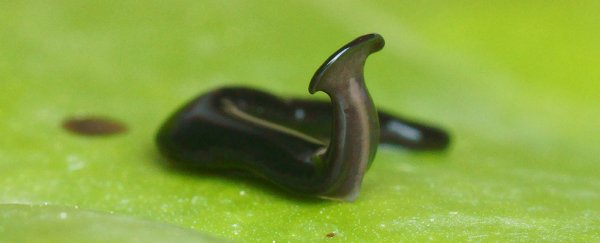COVID-19 has infected every part of our lives over the last two years. The ways we work, engage with our surroundings, and see family and friends have all been drastically altered during the ongoing pandemic.
By far the worst have been the deaths of all the loved ones the disease has taken from us. Now, partly in recognition of the people lost, researchers have named a newly discovered species of hammerhead flatworm Humbertium covidum.
"The specific name covidum was chosen as homage to the numerous casualties worldwide of the COVID-19 pandemic," the team, led by the National Museum of Natural History, France parasitologist Jean-Lou Justine, writes in their new paper.
"Furthermore, a large part of this study was written during the lockdowns."
Hammerhead flatworms (known as the genus Bipalium) are a type of predatory land worm with a distinctive hammer-shaped head. Many of them have used us and our love of plants to sneak a ride all around the world, and many are invasive species in the US and Europe.
H. covidum is small, around 3 centimeters long (just over an inch), and metallic black in color with no stripes or other ornamentation, which is rare for flatworms. It was found in a couple of gardens in France and Italy.
The researchers also describe the worms' genitals in considerable detail, which is an important method for telling apart the different species and subfamilies. All flatworm species are hermaphroditic, so their reproduction can be either sexual or asexual.
 Humbertium covidum. (Pierre Gros)
Humbertium covidum. (Pierre Gros)
This little COVID creature wasn't the only hammerhead flatworm discovered by the team. They also found one on a French island called Mayotte, resulting in the species name Diversibipalium mayottensis. This one is also around 3 cm long, and sports a pretty blue-green speckle (which the researchers call a "dark turquoise glitter") over a brown base.
Unfortunately, these flatworms probably didn't originally call France and Italy home. Using next-generation sequencing to analyze where the two species were in the larger family tree, the team suggests that both species are from abroad – H. covidum from somewhere in Asia, and D. mayottensis from Madagascar.
"H. covidum is probably a species originating from Asia and is an alien species in Europe," the team writes.
"Whether it will become an invasive species needs to be monitored in the future."
 Diversibipalium mayottensis. (Laurent Charles)
Diversibipalium mayottensis. (Laurent Charles)
These are not the only flatworms that have successfully migrated to other countries. Other species like Obama nungara in Europe (originally from Argentina), Platydemus manokwari in the US (from New Guinea) and Bipalium kewense in France (from Southeast Asia) all hitched a ride via the plant trade from one place to another.
The team used genetic sequencing on the stomach contents of H. covidum to discover the hammerhead worm had been eating slugs and snails, which could affect the ecosystem of the area.
Interestingly, apart from three gardens (two in France and a third in Italy) in which H. covidum was discovered between 2013 and 2019, there have been limited cases of the worm being found elsewhere.
"In 2019, an intensive campaign on Twitter in various European languages asking for additional reports, did not provide any additional information," the team writes in their paper.
Unfortunately, although the researchers were able to get their hands on specimens of H. covidum, they weren't able to get enough specimens of D. mayottensis to fully describe the species. Despite that, the researchers believe that D. mayottensis could belong to an entire new group of hammerhead flatworms.
"In all phylogenies, D. mayottensis was the sister-group of all other bipaliines, suggesting that it represents a distinct genus, which needs formal description; this will await availability of additional specimens," the team writes.
"External morphology superficially suggests that the species is close to Humbertium, but the reproductive anatomy is unknown."
The research has been published in Peer J.
